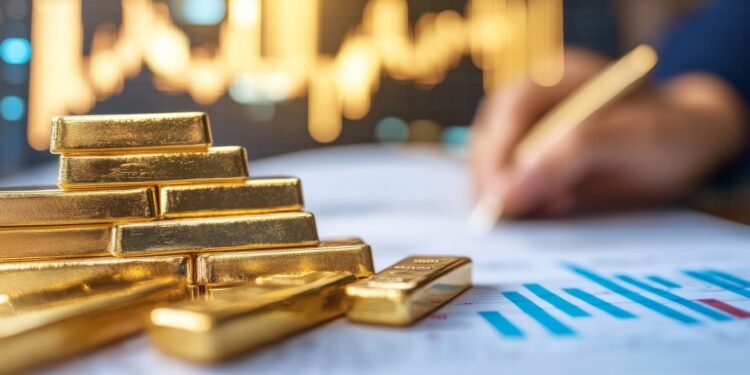Throughout human history, gold has maintained a unique position in the global economy as the quintessential safe haven during periods of political upheaval and economic instability. The precious metal’s enduring value, universal recognition, ease of transport, and liquidity across international borders have cemented its reputation as a reliable store of wealth when conventional financial systems face turbulence. In 2025, this centuries-old pattern is repeating itself with remarkable intensity.
The Current Gold Rush
The recent surge in gold prices tells a compelling story about investor sentiment in today’s uncertain economic landscape. The spot price of gold has shattered previous records, climbing above $3,500 per ounce in mid-April 2025 and continuing what has been described as a ferocious price run that began last year. This precious metal has outperformed nearly every other major asset class so far this year, attracting significant attention from investors worldwide.
Evidence of this renewed enthusiasm for gold appears in the substantial inflows to gold-backed exchange-traded funds (ETFs), which reached $21 billion in the first quarter alone, according to data from the World Gold Council. This represents the highest level of investment since the COVID-19 pandemic, reflecting growing concerns about geopolitical tensions and economic policy shifts.
China, simultaneously the world’s largest gold producer and consumer, has been a major driver behind this remarkable price ascent. Chinese investors have increasingly turned to gold amid concerns about the punitive tariffs imposed by U.S. President Donald Trump on American imports of Chinese goods, which threaten to disrupt the complex trade relationship between the world’s two largest economies.
The Safe Haven Appeal
While legendary investor Warren Buffett has famously dismissed gold as a “sterile” asset—noting in a 2011 letter to Berkshire Hathaway shareholders that “if you own one ounce of gold for an eternity, you will still own one ounce at its end”—many investors clearly disagree with this assessment, particularly during periods of heightened uncertainty.
For contemporary investors, gold’s appeal stems primarily from its stability and liquidity rather than any inherent utility. The precious metal has consistently demonstrated its ability to maintain or increase value during market stress, providing a reliable hedge when more conventional assets falter. This counter-cyclical performance makes gold particularly attractive when traditional markets exhibit volatility.
Gold also serves as a recognized hedge against inflation—a growing concern for many investors as Trump’s new import duties and the retaliatory measures implemented by other nations threaten to drive up prices across the global economy. When the purchasing power of paper currencies erodes during inflationary periods, gold typically retains its value, preserving wealth when other assets might not.
The current economic climate has elevated gold’s safe-haven status to new heights as Trump’s trade policies have shaken confidence in other traditional shelters from market turbulence—most notably the U.S. dollar and government bonds. These policies have challenged the concept of American exceptionalism in financial markets, pushing investors toward alternative stores of value.
Historically, gold has maintained a negative correlation with the U.S. dollar. Because gold is priced in dollars globally, a weakening greenback makes the precious metal more affordable for holders of other currencies, often boosting demand. This relationship has been evident in recent months, with the dollar reaching a three-year low against other major currencies by mid-April, coinciding with gold’s record-breaking rally.
Cultural and Historical Significance
Beyond pure market dynamics, gold ownership is deeply embedded in the cultural fabric of many societies, particularly in India and China—two of the world’s largest markets for the precious metal. In these cultures, gold jewelry, bars, and other forms of bullion are traditionally passed down through generations as symbols of prosperity and security.
Indian households collectively own an estimated 25,000 metric tons of gold—more than five times the amount stored in the U.S. depository at Fort Knox. While these consumer markets are notably price-sensitive, they often provide important support for the gold market. When investment demand begins to wane and prices retreat, physical buyers of jewelry and bars frequently step in to capitalize on lower prices, effectively establishing a floor for the market.
Central Bank Purchasing: A Key Driver
While trade war fears have certainly contributed to gold’s remarkable performance, the metal’s blistering price rally since early 2024 has been substantially fueled by aggressive purchasing from central banks, particularly those in emerging market economies. These institutions have increasingly sought to reduce their dependence on the U.S. dollar—the world’s primary reserve currency—by diversifying their foreign exchange reserves with gold.
Central banks have been net buyers of gold for the past 15 consecutive years, but the pace of their acquisitions doubled following Russia’s invasion of Ukraine. This acceleration reflects growing concerns about the vulnerability of foreign currency assets to international sanctions, as demonstrated when the United States and its allies froze Russian central bank funds held in their jurisdictions.
In 2024, central banks collectively purchased more than 1,000 tons of bullion for the third consecutive year, according to World Gold Council data. Central banks now hold approximately one-fifth of all gold ever mined throughout human history, underscoring the metal’s continued importance in official reserve management strategies.
This sustained enthusiasm from central bank buyers prompted Goldman Sachs Group Inc. to revise its year-end forecast for gold prices upward to $3,700 per ounce in April. The investment bank further projected that prices could reach $4,000 by mid-2026, signaling continued optimism about gold’s prospects despite its already substantial gains.
Potential Challenges to the Rally
After gold’s nearly uninterrupted upward trajectory since early last year, some market participants anticipate a period of consolidation as investors lock in profits. Significant diplomatic developments—such as a major de-escalation of Trump’s tariff policies or a peace agreement between Russia and Ukraine—could potentially trigger price declines by reducing the market’s risk premium.
However, central banks remain the most significant pillar of support for gold’s bullish momentum, meaning any substantial change in their purchasing patterns could profoundly impact the market. There is currently no indication that any large holder is contemplating significant sales of their gold reserves.
This stands in stark contrast to the 1990s, when persistent sales by central banks in developed economies drove bullion prices down by more than 25% over the decade. Concerns about market destabilization from these uncoordinated sales eventually led to the first Central Bank Gold Agreement in 1999, under which signatories committed to limiting their collective gold sales.
Practical Considerations for Investors
While gold offers numerous advantages as a safe-haven asset, ownership typically involves certain costs. As a physical commodity, holders must account for expenses related to storage, security, and insurance—considerations that don’t apply to financial assets like stocks or bonds.
Investors purchasing physical gold in the form of bars and coins generally pay a premium above the spot price to cover minting, distribution, and dealer margins. Geographic price differentials also exist within the global gold market, creating arbitrage opportunities for traders.
This dynamic was prominently displayed earlier this year when concerns about potential Trump tariffs on bullion imports pushed gold futures prices on New York’s Comex significantly above spot prices in London. This price gap triggered a worldwide scramble among physical gold holders to transport metal to the United States to capture the substantial premium, potentially realizing hundreds of millions of dollars in profit.
While gold is relatively simple to transport—typically carried in the cargo holds of commercial aircraft, unknown to passengers traveling above—a technical aspect of the global gold market creates logistical challenges. Different markets maintain different size requirements for gold bars: London’s standard is 400-ounce bars, while Comex contracts require delivery of 100-ounce or 1-kilogram bars.
Consequently, bullion being transferred from London to Comex warehouses must first be sent to refiners in Switzerland, where the large bars are melted down and recast to the correct dimensions before continuing their journey to the United States. This process creates a bottleneck during periods of heightened demand for physical relocation of gold stocks.
The Outlook for Gold
As geopolitical tensions persist and economic uncertainties continue to ripple through global markets, gold’s safe-haven status appears secure. The precious metal’s performance throughout 2025 has reinforced its reputation as a reliable store of value during turbulent times, attracting investors seeking stability amid market volatility.
While gold prices may experience periodic corrections and consolidations—natural occurrences in any bull market—the fundamental drivers of its recent strength remain intact. Central bank diversification efforts, geopolitical risks, trade tensions, and inflation concerns continue to support investment demand, while cultural factors ensure ongoing physical consumption in key markets like India and China.
For investors navigating today’s complex financial landscape, gold’s millennia-long history as a store of value offers a reassuring constant in an increasingly uncertain world. Whether this ancient metal continues its record-breaking ascent or eventually stabilizes at new equilibrium levels, its role in portfolio diversification and wealth preservation seems unlikely to diminish anytime soon.
Acknowledgment: This article was written with the help of AI, which also assisted in research, drafting, editing, and formatting this current version.







